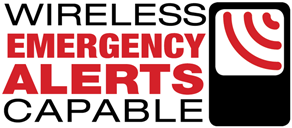
And check out real stories of how WEA has saved lives across America. |
|
 |
Why did I receive an alert when there was no warning in effect for my location?
WEA messages are broadcast using radio-like technology from cell towers in, and sometimes around, the actual warning area. If your device is not capable of WEA 3.0 (see item #10 above), an alert can reach cell phones outside of the actual warning area depending on the broadcast range of the cell towers which broadcast the alert.
How will I receive alerts if I don't have a WEA-capable device?
WEA is one of many ways you can receive emergency notifications. Other sources include NOAA Weather Radio, news media coverage, the Emergency Alert System on radio and TV broadcasts, desktop applications, mobile applications, and other alerting methods offered by local and state public safety agencies.
How does the NWS activate a Wireless Emergency Alert on my cell phone?
The NWS pushes our suite of warnings, advisories, and watches to a national collection point called the Integrated Public Alert and Warning System (IPAWS). The NWS specially marks our most critical NWS alerts for WEA distribution, so that when they reach IPAWS, they are pushed to commercial wireless carriers who broadcast the alert from cell towers in the threat area to your cell phone. IPAWS also serves as collection point for non-weather alerts, such as civil and child abduction emergency messages which are issued by other emergency authorities. Once an alert is in IPAWS, the alert may be made available through a variety of channels for further distribution, such as broadcast over television/radio stations, sirens, display on highway signs, desktop and mobile alert software application, and the Wireless Emergency Alert system.
WEA Factsheet (PDF) - Download a factsheet on Wireless Emergency Alerts.